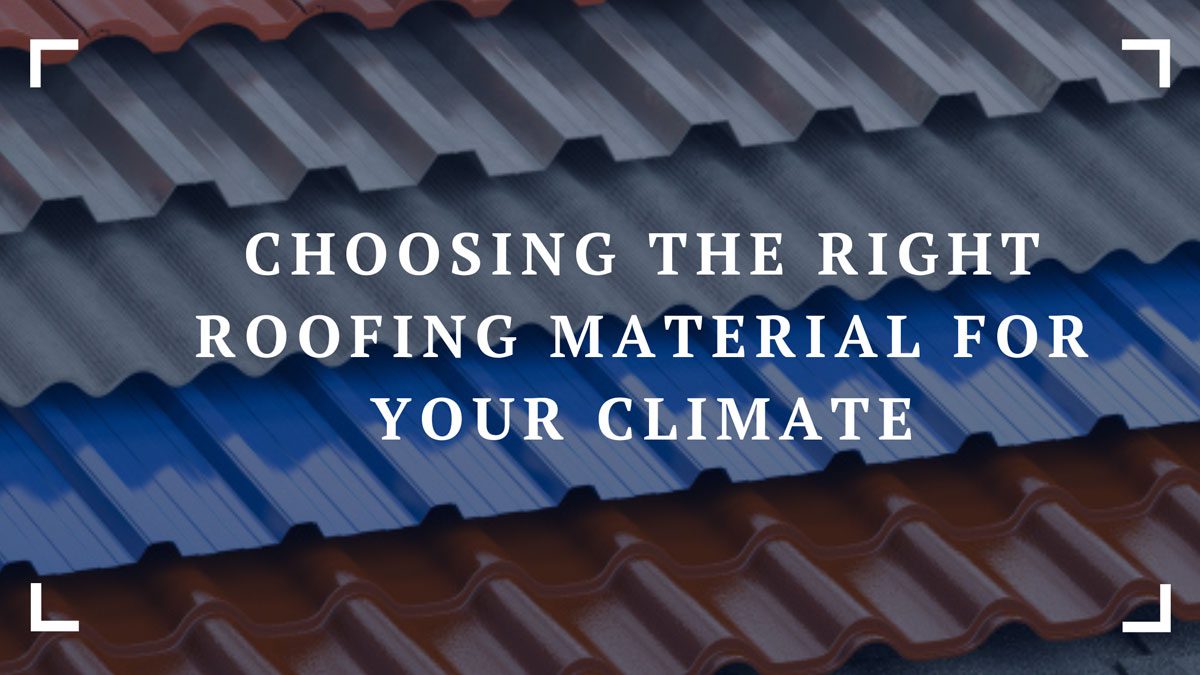Roofing is one of the most essential elements of a home. It’s not just an aesthetic feature; it’s the primary shield against the elements, from the blazing sun to freezing snow. With such a pivotal role, it’s crucial that homeowners select the right roofing material – one that’s tailored not just to the design of their house but more importantly, to the climate they live in.
Different climates pose unique challenges for roofs. What works exceptionally well in a tropical setting might falter in a cold, snowy environment. So, how do homeowners ensure they make the right choice? Let’s dive in.

Hot and Dry Climates: Reflect and Repel
For those living in hot, arid regions, the primary goal is to reflect the sun’s rays and minimize heat absorption.
- Materials to Consider: Light-colored or ‘cool’ roofs, metal roofing with reflective coatings, and clay or slate tiles are excellent choices. They effectively bounce back the sun’s rays, reducing indoor temperatures and energy costs.
- Avoid: Dark-colored asphalt shingles which can absorb and retain heat.
Tropical Climates: Breathability is Key
In areas with high humidity and rainfall, roofs must resist moisture while allowing the home to breathe.
- Materials to Consider: Natural materials like clay, slate, and terra cotta tiles are beneficial. They resist mold and mildew while offering natural ventilation. Additionally, metal roofing with proper coatings can prevent rust and withstand heavy rainfalls.
- Avoid: Wood shingles, unless treated for moisture resistance, as they can warp or rot.
Cold and Snowy Climates: Insulate and Endure
Cold regions demand roofing materials that offer insulation and can withstand the weight of snow.
- Materials to Consider: Dark-colored asphalt shingles, metal roofs with a snow guard, and slate tiles are preferable. They help in retaining indoor heat, and their smooth surfaces enable snow to slide off easily.
- Avoid: Lightweight materials that might buckle under the weight of snow.
Coastal Climates: Withstand the Salty Air
For homes near the coast, the salty sea air can be corrosive. Hence, roofing materials need to be robust and resistant to such conditions.
- Materials to Consider: Metal roofs made of aluminum or galvanized steel are ideal as they resist corrosion. Cedarwood shingles or shakes, when treated, can also endure salty air while providing a charming coastal aesthetic.
- Avoid: Untreated metals which can corrode quickly.
Mixed Climates: Versatility Matters
For regions experiencing a mix of all seasons, versatility in roofing material is the key.
- Materials to Consider: Asphalt shingles are a popular choice because of their adaptability. They can handle rain, heat, and moderate snow. Composite roofing materials also offer versatility with added durability.
- Avoid: Highly specialized materials meant for singular climates.
Local Expertise Can Make a Difference
While it’s crucial to consider the broader climate categories, local variations, microclimates, and specific weather patterns unique to your region can play a significant role. This is where tapping into local expertise can make all the difference. For instance, consulting with a Fairfax roofer would give homeowners insights tailored to that specific region, ensuring a more nuanced approach to material selection.
Maintenance Matters
Remember, no matter the material, regular maintenance is essential. Even the best-suited roofing material can falter without periodic checks, especially after extreme weather conditions. It’s always a good idea to have a professional assess the roof at least once a year.
Budget Considerations
While it’s essential to prioritize the climate, one cannot ignore budgetary constraints. Some materials, while perfect for a particular climate, can be cost-prohibitive. In such cases, homeowners can explore newer, composite materials that might offer a balance between cost, durability, and climate suitability.
Environmental Impact: Thinking Green
In an age where sustainable living is more than just a trend, the environmental impact of our choices cannot be ignored. Picking roofing materials that are sustainable and have a lower carbon footprint not only helps the environment but can also result in better overall efficiency for your home.
- Materials to Consider: Green or living roofs, which are partially or completely covered with vegetation, not only provide excellent insulation but also combat urban heat islands. Recycled shingles made from post-consumer waste and reclaimed wood, metal, and slate are also eco-friendly options that minimize waste and energy consumption.
- Avoid: Non-recyclable materials that contribute to landfill waste.
Technological Advancements: The Future of Roofing
The roofing industry, like many others, is undergoing rapid technological advancements. Modern solutions offer enhanced durability, energy efficiency, and even automation features.
- Materials to Consider: Solar shingles are a groundbreaking innovation, merging the functionality of solar panels with the protection of standard shingles. They capture sunlight and convert it into electricity, aiding in energy conservation. Additionally, cool roofing materials, made using highly reflective types of paint, sheet coverings, or reflective tiles/shingles, can reflect more sunlight and absorb less heat than traditional roofs.
- Avoid: Outdated materials that lack the latest protective coatings or technologies, which might offer subpar performance in extreme climates.
Conclusion
Choosing the right roofing material isn’t just about matching it with your home’s design; it’s about syncing it with the climate to ensure longevity and efficiency. It’s an investment in comfort, safety, and peace of mind. With the right choices, homeowners can rest easy, knowing they’re shielded from the elements in the best possible way.


